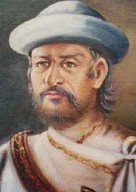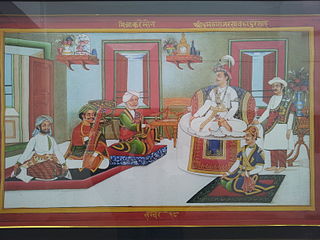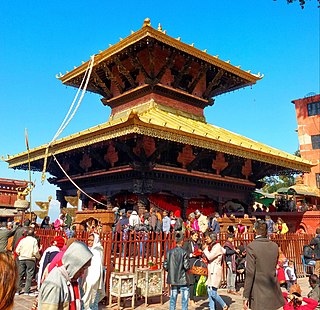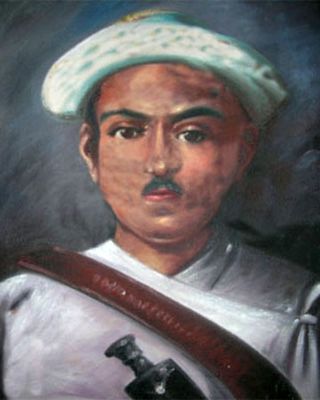
The Kingdom of Nepal was a Hindu kingdom in South Asia, formed in 1768 by the expansion of the Gorkha Kingdom, which lasted until 2008 when the kingdom became the Federal Democratic Republic of Nepal. It was also known as the Gorkha Empire, or sometimes Asal Hindustan. Founded by King Prithvi Narayan Shah, a Gorkha monarch who claimed to be of Thakuri origin from chaubisi, it existed for 240 years until the abolition of the Nepalese monarchy in 2008. During this period, Nepal was formally under the rule of the Shah dynasty, which exercised varying degrees of power during the kingdom's existence.

The Magars, also spelled Mangar and Mongar, are Tibeto-Burman ethnic group native to Nepal and Northeast India, representing 6.9% of Nepal's total population according to the 2021 Nepal census. They are one of the main Gurkha tribes.

The Gorkha Kingdom also known as the Gorkha Confederation and popularly known Gorkha Empire was a member of the Chaubisi rajya, a confederation of 24 states, located at the intersection of Himalayas and the Indian subcontinent. In 1743, the kingdom began a campaign of military expansion, annexing several neighbors and becoming present-day Nepal.

The Shah dynasty, also known as the Shahs of Gorkha or the Royal House of Gorkha, was the ruling Chaubise Thakuri dynasty and the founder of the Gorkha Kingdom from 1559 to 1768 and later the unified Kingdom of Nepal from 1768 to 28 May 2008.

The unification of Nepal was the process of building the modern Nepalese state, from fractured petty kingdoms including the Baise Rajya and the Chaubisi Rajya, which began in 1743 AD. The prominent figure in the unification campaign was Prithvi Narayan Shah, King of Gorkha. On 25 September 1768, he officially announced the creation of the Kingdom of Nepal and moved his capital from Gorkha to the city of Kathmandu.

Basnyat/Basnet family or Basnyat/Basnet dynasty was a Khas-Chhetri and a warlord clan family involved in the politics and administration of the Gorkha Kingdom and Kingdom of Nepal. This family got entry into Thar Ghar aristocracy group of Gorkha at the time of King Prithvi Narayan Shah. It was one of the four noble families to be involved in active politics of Nepal together with the Shah dynasty, Pande family and the Thapa dynasty before the rise of the Rana dynasty. This family is descended from Shivaram Singh Basnyat, the commander of Gorkhali forces and a member of Shreepali Basnyat clan of Gorkha. This family was maritally linked to Kala (Black) Pande section of the Pande dynasty through Chitravati Pande who married Kaji Kehar Singh Basnyat. This family was the last Kshatriya (Chhetri) political family to be wiped out from the central power by Jung Bahadur Rana of Kunwar family during the Bhandarkhal Massacre in 1846 for the conspiracy to take the power leading to people suffering from 104 long years of the Rana rule.

Thapa (pronunciation:[t̪ʰapa]) is an Indo-Aryan surname belonging to the Chhetri caste (Rajput) in Nepal and parts of Northern India.[2][3] It is also used by the Magar group, a Sino-Tibetan speaking ethnicity.

Chaubisi Rajya, Chaubise Rajya or Chaubisye Rajya, were sovereign and intermittently allied petty kingdoms ruled by the Magar and Thakuri kings located at the intersection of Himalayas and the Indian subcontinent. One of these kingdoms, Gorkha, annexed the others, becoming the present-day country of Nepal. This conquest began soon after Prithvi Narayan Shah ascended to the Gorkha throne in 1743 AD. The Chaubisi Rajya were annexed during the unification of Nepal from 1744 to 1816 AD. A parallel group of 22 small kingdoms, Baisse Rajya, existed to the west of the Gandaki Basin.

Manakamana Temple is a Hindu temple dedicated to goddess Bhagwati, an incarnation of Parvati and it is situated in the village of Manakamana in Gorkha District, Gandaki Province, Nepal founded by Arman Rayamajhi in 1678.

The Government of Nepal is the federal executive authority of Nepal. Prior to the abolition of the Nepali monarchy in 2006, it was officially known as His Majesty's Government.

Lakhan Thapa Magar (1835–1877) was a Nepali revolutionary who was declared the "First Martyr of Nepal" by the Nepalese government. He was the first recorded Nepali political dissident and resisted the rule of the Rana dynasty. As a king of Bungkot, he rebelled against the rule of Jang Bahadur Rana and propagandized his political ideology to destroy the Jung Bahadur Rana regime to form a free state and army. He was supported by his close friend Jay Singh Chumi Magar and his minister Jaya Singh Chumi.

Kaji was a title and position used by nobility of Gorkha Kingdom (1559–1768) and Kingdom of Nepal between 1768 and 1846. Many other contemporary kingdoms used the same title for their ministers.

Kaji Biraj Thapa Magar played an important role in the Gorkha Kingdom. His leadership, prudence and courage all exhibit that he was one of the important Gorkha Bhardars that helped Narbaupal Shah become King of Gorkha. He may also be seen as a King Maker in the modern day term. According to different genealogies, he had taken Narabhupal Shah and his mother Malikavati in custody for three months. The Queen Mother and her son were secretly protected at his residence. After the death of his grandfather, Narabhupal Shah became the King of Gorkha in 1716 and died in 1743. His son, King Prithvi Narayan Shah, succeeding him began unification of small principalities to found modern Nepal.

Vamshidhar Pande known by Alias Kalu Pande was a Nepalese politician and general who was appointed as Kaji of The Gorkha Kingdom. He was born in 1713 A.D. in a Gorkha family. He was the commander of the Gorkhali forces during the Unification Campaign of Nepal who died in the first Battle of Kirtipur in 1757 A.D. Pande's real name was Banshidhar Pande. He was a son of Kaji Bhimraj Pande who was minister during reign of King Prithivipati Shah of Gorkha. He was descendant of Minister of Gorkha and Dravya Shah's accomplice Ganesh Pande. He had three sons: Dewan Kajisaheb Vamsharaj Pande, Sardar Ranasur Pande and Mulkaji Sahib Damodar Pande.
Ganesh Pandey or Ganesa Pande
Dalbhanjan Pande or Dalabhanjan Pande was a Nepalese minister, politician and military officer of the aristocratic Pande family. He had held ministerial positions and military offices. He jointly headed the military administration of Nepal in 1837 along with Mukhtiyar Rana Jang Pande.
The Chief of the Nepalese Army is the military position of army head of the Nepalese Army, initially known as Gorkhali Army. The Chief of the Nepalese Army had been from among the Kaji officers during the 18th century. During the reign of Bhimsen Thapa, the title of Commander-in-Chief was introduced for the first time for denoting the army chief. Later in the late 1970s, the title was changed to Chief of Army Staff (CoAS). Currently, the Chief of Army Staff is the Chief of the Nepalese Army.Gurung Magar Thakuri were thakurai/chatrapal/thakurs /kings of western Nepal.Some of chief army head of Nepal is missing.
Battle of Khurbura or Battle of Khudbuda also known as Gorkha-Garhwal War occurred in May 1804 near modern-day village of Dehradun, Khurbura 30.3256°N 78.0267°E. The battle is regarded as the first major attack in the history of Garhwal Kingdom that triggered between Kingdom of Nepal forces and Maharaja Pradyumna Shah, and continued for 13 days until the Garhwal king was defeated. It is chiefly regarded the only defeat of Pradyumna Shah's life and the victory of Gorkhali forces under Kingdom of Nepal.

The Battle of Nuwakot also called Siege of Nuwakot or Invasion of Nuwakot was fought in Nuwakot in 1744. Nuwakot was controlled by the Kingdom of Kantipur and it was an important location as it had a trade route to Tibet. The Gorkha Kingdom previously attacked twice by Nara Bhupal Shah and his son Prithvi Narayan Shah respectively. To prepare for the war Prithvi Narayan Shah visited Varanasi to get war materials, ammunition, acquire weapons, train the soldiers, and Pilgrims. He improved his army personnel and included people from any caste including the blacksmiths, cobblers, sweepers, Damai, and anyone who was bodied and physically fit was able to join the crew.















